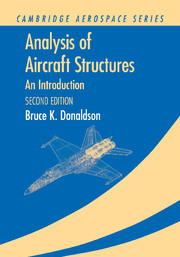Book contents
- Frontmatter
- Contents
- Introduction to the Second Edition
- Introduction to the First Edition
- List of Repeated Engineering Symbols
- Acknowledgments
- Part I The Fundamentals of Structural Analysis
- 1 Stress in Structures
- 2 Stresses and Coordinate Axis Rotations
- 3 Displacements and Strains
- 4 Strains in Rotated Coordinate Systems
- 5 The Mechanical Behavior of Engineering Materials
- 6 Linearly Elastic Materials
- Part II **Introduction to the Theory of Elasticity**
- Part III Engineering Theory for Straight, Long Beams
- Part IV Work and Energy Principles
- Part V Energy-Based Numerical Solutions
- Part VI Thin Plate Theory and Structural Stability
- Appendix A Additional Topics
- Appendix B Selected Answers to Exercises
- References
- Index
4 - Strains in Rotated Coordinate Systems
from Part I - The Fundamentals of Structural Analysis
Published online by Cambridge University Press: 05 June 2012
- Frontmatter
- Contents
- Introduction to the Second Edition
- Introduction to the First Edition
- List of Repeated Engineering Symbols
- Acknowledgments
- Part I The Fundamentals of Structural Analysis
- 1 Stress in Structures
- 2 Stresses and Coordinate Axis Rotations
- 3 Displacements and Strains
- 4 Strains in Rotated Coordinate Systems
- 5 The Mechanical Behavior of Engineering Materials
- 6 Linearly Elastic Materials
- Part II **Introduction to the Theory of Elasticity**
- Part III Engineering Theory for Straight, Long Beams
- Part IV Work and Energy Principles
- Part V Energy-Based Numerical Solutions
- Part VI Thin Plate Theory and Structural Stability
- Appendix A Additional Topics
- Appendix B Selected Answers to Exercises
- References
- Index
Summary
Introduction
In Chapter 3 the concept of strains was developed for a single Cartesian coordinate system. The same two questions that were raised with regard to stresses referenced to a single Cartesian coordinate system can be raised with respect to strains: (i) do the strains in one Cartesian coordinate system uniquely determine the strains in another Cartesian coordinate system that is translated and rotated with respect to the first coordinate system; and (ii) how are the maximum strains determined? After the experience gained with stresses, it may be tempting to assume that the answer to the first question is in the affirmative. However, unlike stresses which involve force components, and therefore can be summed using Newton's second law, strains are only a matter of geometry. Therefore, at this point, since they do not share a common basis, no parallel can be drawn between stresses and strains with regard to the translation and rotation of Cartesian coordinate axes. The question has to be investigated anew.
Strains in Other Cartesian Coordinate Systems
The translation of Cartesian coordinate axes has no effect on longitudinal strains simply because longitudinal strains are measures of the differences between displacements at neighboring material points in a structural body. The description of the magnitudes of relative displacements in any particular coordinate axis direction is wholly unaffected by a translation of the origin of that coordinate axis.
- Type
- Chapter
- Information
- Analysis of Aircraft StructuresAn Introduction, pp. 95 - 108Publisher: Cambridge University PressPrint publication year: 2008



